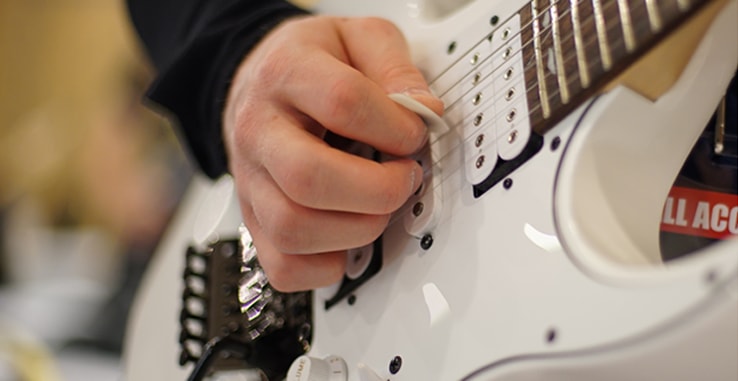How To Play Lead Guitar Licks Using Major 6ths And Minor 6ths
by Tom Hess
Emotion To Any Guitar Lick

EMAIL TO GET ACCESS
By submitting your info, you agree to send it to Tom Hess Music Corporation who will process and use it according to their privacy policy.
Start playing guitar licks using 6ths.
(That is, both the major 6th and the minor 6th.)
What’s so special about lead guitar licks using 6ths?
Answer:
Lead guitar licks using 6ths are rare. (Neither major 6ths nor minor 6ths are often heard in your typical pentatonic-based lead guitar playing.)
And that means…
…when you start improvising with 6ths and using 6ths in your lead guitar playing, your solos begin to stand out.
Emotion To Any Guitar Lick

EMAIL TO GET ACCESS
By submitting your info, you agree to send it to Tom Hess Music Corporation who will process and use it according to their privacy policy.
Using 6ths in your lead guitar playing is not any harder than using any other interval. After you see a few examples of licks based on 6ths intervals, you can easily start creating your own guitar licks using the major 6ths and minor 6ths.
To begin, watch this video on how to use major 6ths & minor 6ths to create guitar solos:
Question: “Tom Hess, how do I know when to use major 6ths and when to use minor 6ths? Both intervals sound good, but how do I know which of the 2 intervals to use when I'm improvising with 6ths?”
Answer: The answer to using the minor 6ths vs. the major 6ths interval comes down to understanding music theory. In every major and minor key, you’ll find both minor 6ths and major 6ths intervals.
You play either the minor 6th or the major 6th interval depending on which interval allows you to stay in key.
For example, if you are improvising with 6ths a major key and you start with the first note of the scale, the interval would be a major 6th (from 1 up to 6) – assuming you want to stay in key.
But if you start on note 3 and go up a 6th – you’d be playing a minor 6th, assuming you want to stay in key.
The better you understand music theory, the easier it becomes to create guitar licks based on 6ths intervals.
Now that you know the basics of how to use major 6ths & minor 6ths to create guitar solos, here are 5 more advanced ways to use lead guitar licks using 6ths:
Tip #1 For Using 6ths In Your Lead Guitar Playing: Play Harmonies Using The Major 6th And The Minor 6th
You probably already heard melodies harmonized in 3rds. You may have even tried to play some.
But have you ever tried harmonizing melodies using the minor 6th and the major 6th? If not, here is a great opportunity to practice improvising with 6ths.
Try this: Create a repeating chord progression (it’s easiest to do this in a tab editing program) and write a melody over it.
Then harmonize your melody by playing the same thing by using major 6ths and minor 6ths.
Repeat this using several melodies (harmonize each one using intervals of a 6th).
You could potentially create an entire guitar solo using only licks based on 6th intervals.
2 additional tips about writing lead guitar licks using 6ths:
1. You can train yourself to play lead guitar licks using 6ths by singing them first. Yes, by singing.
One of the reasons few guitar players feel comfortable improvising with 6ths is because they have a hard time imagining what these intervals sound like.
Solution?
Do the above exercise (of creating a harmony using the major 6th and the minor 6th) by singing the harmony, instead of playing it on guitar.
This trains your ear and helps you imagine the sound of licks based on 6th intervals as you improvise.
Question: “But Tom Hess, what if I have a hard time singing the interval of a major 6th or a minor 6th?”
Answer: Move the chord progression or the melody into a comfortable octave. And keep all your melodies within 1 octave (for this exercise). Problem solved :)
Question: “What if I struggle to find the right note with my voice as I try to create a harmony or improvise using 6ths?”
Answer: It means you are singing the notes too fast. Slow everything way down to give your brain and your ear time to find the sound of the major 6th and minor 6th interval.
2. Your vibrato needs to be in sync between the 2 melodies of your harmony.
Believe it or not, the secret to a great sounding harmony (whether you harmonize in 3rds or in intervals of a major 6th or minor 6th) is…
… your vibrato.
The vibrato of the 2 melodies of the harmony needs to lock in perfectly tight to sound good.
Watch this video to see how to make this possible:
Tip #2 For Using 6ths In Your Lead Guitar Playing: Play Lead Guitar Licks Using 6ths On One String Using Super Slides.
What are super slides? They are unusually large slides (that sometimes span an octave or more). And you can use this technique to play licks based on 6ths intervals.
Here is an example of how to use 6ths in your lead guitar playing with super slides:
Start on the 3rd string 2nd fret (note A) and pretend you are improvising with 6ths in the key of A natural minor. Slide up a minor 6th (up to F) and slide back down to A.
Then play another note (staying in the key of A minor). For example: D. Slide up a major 6th (up to B) and back down.
Continue randomly playing other notes in the scale to practice improvising with 6ths.
Then switch to another key – ideally one you are less familiar with. (For example: Eb major.)
And practice creating licks based on 6ths intervals (on one string) in that key.
The side benefit of this is: you learn your fretboard faster and you get better at using 6ths in your lead guitar playing.
Question: “But Tom Hess, this gets pretty boring after 2 minutes! Plus: I can’t come up with any cool licks based on 6ths intervals when I'm on one string. What should I do?”
Answer: The purpose of this assignment is to *practice* improvising with 6ths – not to play the world’s greatest guitar solo. By playing lead guitar licks using 6ths with super slides, you practice this element of your guitar phrasing.
In real solos, you’ll only use this idea once (or twice). But the more you practice creating lead guitar licks using 6ths on one string – the easier it becomes to apply this skill in a real solo.
Watch this video to get even more fun ideas for practicing super slides (on top of using them to play licks based on 6ths intervals):
Question: “Tom Hess, I sometimes miss notes when I make fast position shifts (such as when playing guitar licks on one string using major 6ths and minor 6ths). What can I do?”
Answer: The solution is to look at the fret you’ll be shifting up to BEFORE your hand moves there. This helps you to nail your major 6ths and minor 6ths licks accurately, even on one string.
 Improve Guitar Technique Fast
Improve Guitar Technique FastLearn how to quickly improve
your accuracy on lead guitar.
 Transform Your Guitar Playing
Transform Your Guitar PlayingInstantly improve your guitar
playing with these free tips.
 Become A Faster Guitar Player
Become A Faster Guitar PlayerLearn how to reach maximum
speed in your guitar playing.
Tip #3 For Using 6ths In Your Lead Guitar Playing: Control Excess String Noise
Excess string noise never sounds good… but it can sometimes happen as you are practicing using major 6ths and minor 6ths to create guitar solos.
(Especially if you are using super slides to play major 6ths and minor 6ths on one string.)
String noise can happen if you lift your picking hand off the strings when you do quick slides up (or down) the guitar fretboard.
And on top of muddying up your playing… string noise also kills your lead guitar sustain.
The solution?
The best way to mute string noise in your lead guitar licks is to use thumb muting.
What’s thumb muting?
As you can guess from the name, you rest your picking hand’s thumb on the lower-in-pitch (thicker) strings. Then the thumb slides up and down as you play your licks based on 6th intervals.
And even if you are improvising with 6ths on one string – the thumb stays in contact with the lower strings at all times. This keeps your playing clean.
Question: “But Tom Hess, can’t I also mute string noise using my palm as I practice lead guitar licks using 6ths?”
Answer: Of course you can. But thumb muting is more secure and more consistent. Plus: your guitar pick stays closer to the strings when you are not playing. This makes your picking more efficient and allows you to play faster runs on top of playing lead guitar licks using 6ths.
Are there other ways of muting string noise too?
You bet!
My favorite ones are using your fretting hand index finger to mute the higher strings as you are playing licks based on 6th intervals…
…and using the fingers not holding the pick to mute the higher in pitch strings. This way, as you practice improvising with 6ths, you can be sure that your playing is staying clean.
Here is what that looks like:

Tip #4 For Using 6ths In Your Lead Guitar Playing: Use Double Stops
Most guitarists think the only way to play lead guitar licks using 6ths is melodically (where the notes of the minor 6ths or major 6th interval are separated, like in a melody).
Not so!
You can also create gritty lead guitar licks using 6ths with double stops.
What are double stops?
Double stops happen when you play 2 notes at the same time (something you can easily do when playing lead guitar licks using 6ths).
Watch this video to see how to use double stops in your guitar playing:
How do you practice and play licks based on 6th intervals with double stops?
Here are a few ideas:
1. Memorize interval patterns for major 6ths and minor 6ths on all string sets all over the guitar. Note: licks based on 6ths intervals use different fingerings when you play them using strings 3 and 2 (compared to the other strings of the guitar). This is because of the guitar’s tuning. But with a bit of practice, you will easily learn to play double stop guitar licks based on 6th intervals.
2. Arpeggiate your major 6ths and minor 6ths double stops to create a special gritty sound few guitar players think to use. This means: let the notes of your licks ring together as you improvise with 6ths.
3. Add vibrato to your double stop guitar licks based on 6th intervals. This way of using 6ths in your lead guitar playing makes your licks drip with fire and emotion.
Question: “Tom Hess, I have a hard time controlling my vibrato when playing double stop guitar licks with major 6ths and minor 6ths. Any tips?”
Answer: Yes. Practice making your vibrato consistent, controlled and in tune on one string first (with no double stop and without worrying about using 6ths in your lead guitar playing). The stronger your vibrato is in general, the easier it is to apply it to lead guitar licks using 6ths.
Tip #5 For Using 6ths In Your Lead Guitar Playing: Create Lead Guitar Licks Using 6ths With 2-String Sweep Arpeggios
You’ve practiced using 6ths in your lead guitar playing on one string, you’ve practiced lead guitar licks using 6ths using double stops… what’s next?
Answer: playing minor 6ths and major 6ths intervals as 2-string arpeggios.
This way of using 6ths in your lead guitar playing is ideal for faster playing in metal guitar solos.
Here are a few quick tips that help you sweep pick faster and cleaner as you play guitar licks based on 6th intervals:
1. Don’t allow the notes to ring together. This causes bleeding (a form of string noise). Release each finger from the string after it has played. This helps you separate the notes and play cleanly.
2. Push the guitar pick through the strings and pull it back in a single motion. This makes your playing more efficient and helps you play guitar licks based on 6ths intervals faster and cleaner.
Check out this video for more tips on how to play 2-string arpeggios:
Now that you know how to use major 6ths & minor 6ths to create guitar solos, the next step is to learn even more ways to add fire and expression to your lead guitar playing.
I show you how in my free eGuide “How To Add Fire & Emotion To Your Guitar Licks, Even If You Can’t Play Guitar Fast Yet”. Grab your copy today and discover the lead guitar playing secrets most guitar players will never know.
 About Tom Hess: Tom Hess is a guitar teacher, music career mentor and guitar teacher trainer. He teaches rock guitar lessons online to students from all over the world and conducts instructional live guitar training events attended by musicians from over 50 countries.
About Tom Hess: Tom Hess is a guitar teacher, music career mentor and guitar teacher trainer. He teaches rock guitar lessons online to students from all over the world and conducts instructional live guitar training events attended by musicians from over 50 countries.
 | Forward this article to your friends |

